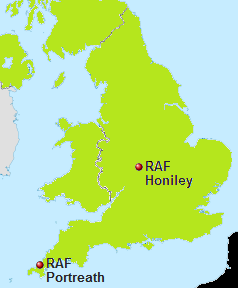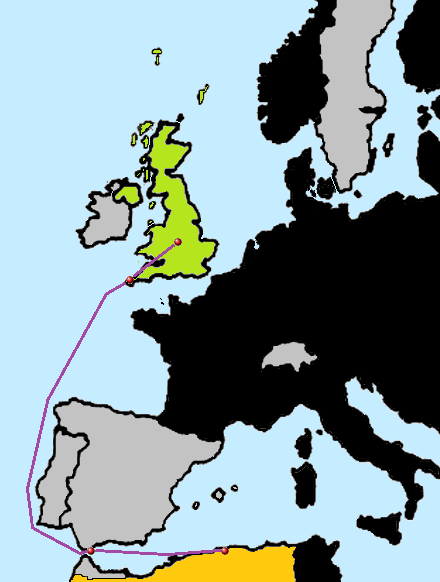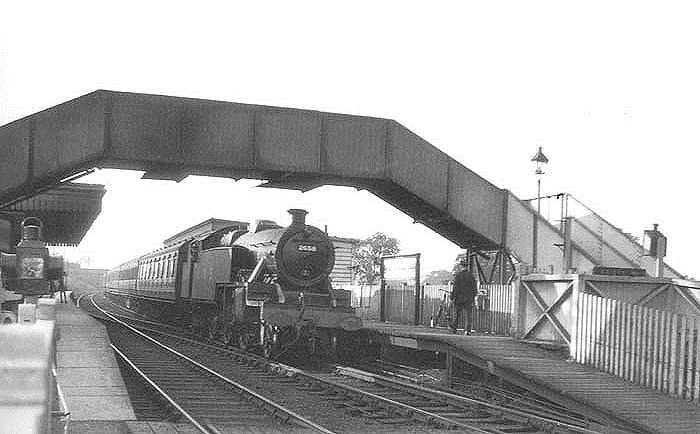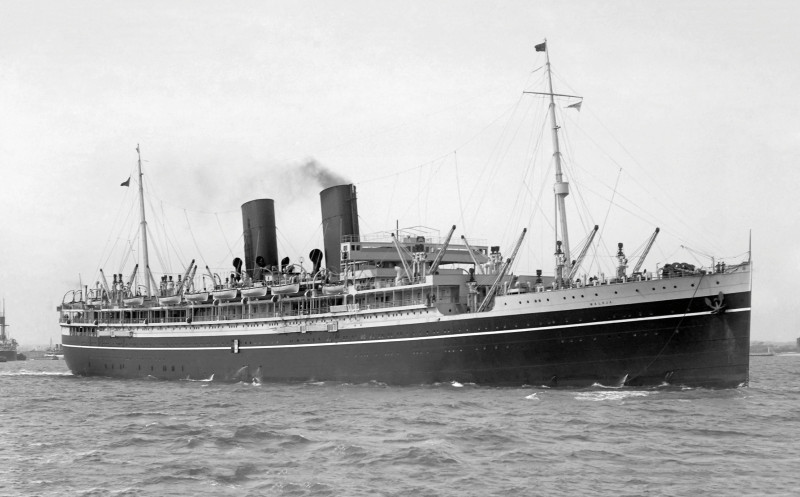The rest of the Squadron travelled by sea...
No. 255 Squadron in action, Algeria and Tunisia
The aircrews were in action almost immediately on arrival, without waiting either for their ground crews or their AI radar sets. All radar equipment had been removed from the aircraft just in case anyone had been forced to land in Spain or Portugal, neither régime being deemed trustworthy as neutrals. But the relatively crude technology of the Mk.IV VHF radar would have told the Germans little even if a set had fallen into their hands intact. In terms of fundamental technology, there was little to choose between it and the Luftwaffe equivalent, as fitted to many Ju.88 and Me.110 aircraft. The Allies’ technologically superior centimetric radar, first seen by 255 in the form of the Mk.VII sets and later as the Mk.VIII, was still (as far as the squadron was concerned) some months in the future.
On the 16th, a mere four days after the official German/Italian occupation of mainland Vichy France, Wing Commander Kelly and Flight Lieutenant Lammer carried out a reconnaisance patrol from Maison Blanche that went as far east as Tébessa, about 20km short of the border with Tunisia. There they encountered an old problem – the similarity of appearance of Beaufighters and Ju.88s when seen from below. The American paratroopers who had captured the airfield but lacked a radio with which to report their success at first hesitated to reveal themselves. But after a short delay they broke cover, confirming the remarkable eastward progress by Allied forces in the early days of the North West Africa campaign.
[7]
However, the response of Axis air forces based in Tunisia and Sardinia was not long in coming. On the 17th an air raid was mounted against Maison Blanche airfield, two Beaufighters of the Squadron taking off during the raid in order to attempt interceptions. Lacking both AI radar and GCI control, they achieved nothing and on return to base encountered the additional problem of the runway being blocked by a delayed action bomb. After some discussion by R/T, they landed anyway.
[8]
A further air raid on the 18th dropped tyre-bursting spikes on the runway along with booby traps resembling Thermos flasks, but the big disaster came on the night of the 20/21 November 1942, described in the ORB thus:
The evening of this day will not easily be forgotten by those who were on the aerodrome, for it brought to them the first major blitz. It was a bright moonlit night and conditions were all in favour of the raiders as the visibility was excellent and there were no AI equipped aircraft available; nor was there a GCI Station working at the time. Although it is thought that only a dozen or less German bombers carried out the raid on the aerodrome they did considerable damage, scoring hits on hangers and aircraft, and starting many fires. It was during this intense period of the raid that the squadron suffered a great loss: F/O Hugh Wyrill, DFC (of 'B' Flight) was killed by shrapnel as he was going out to his aircraft to take off. His Navigator Radio, F/S J. Willins, DFM, who was already waiting in the aircraft, fortunately got away with severe fractures of his right arm and splinter wounds.[9]
The loss of aircraft was considerable; five Squadron Beaufighters were either totally destroyed on the ground or damaged beyond repair and a further four were damaged but subsequently repaired. Freddie Lammer, the Senior Radio Navigator, first helped haul a Flying Fortress clear of the destruction, using only a jeep to tow the 16 tonne aircraft. Freddie then assumed the untutored role of pilot in a valiant attempt to taxy a Beaufighter clear of the destruction. Undeterred by the mistake of spinning the whole aircraft through 360° without actually going anywhere (full throttle on one engine and hard braking on the opposite undercarriage wheel does tend to produce ground loops!), he soon got the hang of adjusting the controls more gently and saved that aircraft too.
[10]
Meantime, 60526 Flying Officer Robert Merton Graham (Pilot) and 109497 Pilot Officer Edward Stanley Hickmore (Navigator) took off in an aircraft known already to have been damaged in the raid, joining three other crews in the air. The ORB again bemoans the absence of AI equipment:
There is nothing more galling than to fly about near the flak, with parachute flares dropping from the Hun aircraft, on a bright moonlit night, and yet see absolutely nothing owing to being without the RDF equipment. The Huns on these nights would have been sitting birds if only our AI equipment had been fitted in the aircraft.[11]
The presence of AMES Type 6 VHF ground-based radar equipment (also known as Light Warning Sets) alone did not prove sufficient to enable proper night fighter interceptions to take place.
On the 21st, a serious breach of security as regards R/T traffic (culprit un-named in the ORB) gave away the fact that two Beaufighters with a Spitfire escort were in the air in daylight. The Beaufighters, both of No.255 Squadron, were conveying Air Marshall Sir William Welsh, KCB, DSC, AFC (Air Officer Commanding) and Group Captain Long (Senior Air Staff Officer, HQ Eastern Air Command) from Maison Blanche to Bône. Some 45 minutes later, the airfield at Bône was straffed by Bf.109s, damaging Wing Commander Kelly’s Beaufighter. Feeling safer in the air than on the ground pending the conclusion of the AOC’s meeting and the return journey, both Beaufighters took off but once airborne Kelly’s was found to have a hydraulic oil leak in consequence of the attack. It being deemed "inadvisable" to crash-land at Bône, Kelly returned to Maison Blanche leaving F/O Cox (Pilot) and F/S Croft with the dubious honour of conveying both senior officers back to Maison Blanche in one aircraft – a "too many eggs in one basket" risk that would not normally have been taken. Aside from that, there were the issues of rank and protocol involved with an Air Marshall being piloted by a Flying Officer of the RAFVR and at least one of the seniors not even having a seat to sit on. Passengers in a Beaufighter were normally squeezed into the space between the back of the pilot’s seat and the cannon magazines.
[12] Just who sat in the one available seat under the navigator’s cupola and performed the very necessary tail-guarding function of Observer is not recorded!
On the 22nd the radar sitution took a turn for the better, with the arrival of GCI specialist and "ace" Controller 74440 Squadron Leader John Laurence Brown ("The Sultan of Sopley") and the equipment needed to set up a full GCI Station. The ORB perpetuates a commonplace error of crediting Brown with an OBE; the only known relevant Gazette entry being the award of an MBE.
[13]
The 24th saw a friendly fire incident in which a Beaufighter piloted by 127032 Pilot Officer Kevin Thomas Anthony O’Sullivan was hit by gunfire from HM Ships, resulting in a perspex splinter temporarily blinding the pilot in one eye. O’Sullivan magaged to crash-land in a thunderstorm after being shepherded home wingtip-to-wingtip by Squadron Leader Player, but the runway was blocked in consequence and Player’s aircraft had to remain in the air for a further 30 minutes before it too could land in what was, by then, a major storm.
[14]
After so many losses, there was a dire shortage of airworthy Beaufighters in Algeria. On the 25th, twelve crews were ordered to return to England to collect twelve brand-new aircraft. They split into three groups of four crews each at Gibraltar for the journey over the Bay of Biscay, close to hostile airspace, one group travelling in a B17 and the rest in DC3s. They re-assembled at RAF Lyneham.
[15]
On the 29th, Mk.IV AI sets were fitted to the surviving Beaufighters at Maison Blanche, following a madcap hunt around Algiers for a petrol-electric generator set suitable for testing the installation on the ground. Still lacking ground crew, most of this work was done by 255 aircrew plus a variety of personnel borrowed from other units on the same site. The first air-tested installation was used on an active patrol on the 30th, but no Germans or Italians obliged by turning up to be shot at.
[16]
At first, accommodation at Maison Blanche was, to say the least, basic. For weight reasons, aircrew had not been permitted to bring bedding with them on the flight from England. The ORB monthly summary for November 1942 reads:
Accommodation. The aircrews were, during this period, entirely on their own without any tentage or other unit equipment. Fortunately two empty buildings were found near the aerodrome. For the first week the officers and NCO aircrew slept on the concrete floor which, compared with the floors of many other buildings, was tolerably clean. Later some beds from the French Air Force Barracks were used; they had no matttresses and having parallel metal strips left the occupants "branded" for some hours after rising every morning. Before these beds were brought into use, it was necessary to remove "crawly creatures" by pouring 100-octane over them and igniting. After a fortnight living in these sheds... washing under a tap with a petrol tin for a basin, it was a great relief to take up residence in the Hotel St.Georges...[17]
Come 2 December 1942, the first of the new Beaufighters arrived from England, followed on the 4th by the much-needed AI sets. Then, on the 5th, the start of a change of tactics...
Order received for three crews to go to our most forward aerodrome in Tunisia, Souk-el-Arba. The idea of working a night fighter squadron so close to the front is a novel one, the tradition being a restriction of its activities to home defence. The more courageous policy adopted by the powers-that-be in this particular instance may well become an eye-opener to the hitherto unexplored possibilities of night fighters being used so close to the front in direct support for our attacking forces.[18]
The adjacent village has, since 1966, been known as Jendouba. By the end of hostilities in North Africa, there were two airfields at Souk-el-Arba. The original (as used by No.255 Squadron) was located immediately to the South-East of the town and was captured by paratroops of the British 1st Parachute Brigade on 16 November 1942.
[19] A second airfield was constructed later by US military engineers, located about 4km to the South-West of the town. Click on the camera icon to see a Luftwaffe aerial photograph of the Souk-el-Arba complex as it was at the beginning of May 1943.
One of the crews sent forward to Souk-el-Arba on the 5th comprised F/O Humes and F/S Sayer. That same evening they opened the Squadron’s scoresheet for North Africa by shooting down two He.111s. The excitement had only just subsided when F/O Gloster reported destroying three He.111s in a space of half an hour.
[20]
On the sixth, Squadron Leader Player bagged a He.111, in the process giving GCI Controller Squadron Leader Brown his one hundredth 'Jerry'. Johnny Player followed this by downing two Cant Z.1007 bis of the Regia Aeronautica.
Not everything was going according to plan, though. The squadron’s Engineering Officer, Flight Lieutenant P.C.Wright, accompanied by Flying Officer E.E.Crouser, the "Signals RDF Officer" (meaning radar specialist), were aboard a vessel in Bône harbour "seeing about some equipment" when the vessel sailed without first putting them ashore. Next stop Algiers!
Another inconvenience at Bône was the Luftwaffe’s habit of bombing the town at night, placing at risk the ground crews sleeping in the Tabacoop warehouse. From the 13th, the whole contingent at Bône slept in the hills and had a grandstand view of the nightly air raid without themselves being in any danger.
At this point, Ain Arnat airfield at Sétif was designated as the squadron’s new maintenance and rest base. Come the 16th, an Advance Party of personnel at Bône commenced the move to Sétif by motor convoy. The remainder would follow by rail, departing the following day. The rail journey proved to be slow and uncomfortable, the rolling stock being cattle trucks marked "8 horses or 40 men" and the journey taking two days. The ORB records...
Fortunately, there were no horses, but unfortunately there was a large accumulation of evidence of their recent presence, much to the disgust of all concerned.[21]
On the 18th it was decided to camp at Macdonald (since re-named El Mahdia)
[22] about 8km to the west and thus well clear of any Axis air attack on the town of Sétif or the airfield at Ain Arnat. For three nights, whilst the tented camp was prepared, squadron personnel slept in a hanger on the airfield. The Officers Mess was established in a villa requisitioned from the Mayor of Macdonald, where it would remain until 6 April 1943.
[23] [24]
On the evening of the 15th, flying out of Souk-el-Arba, Wing Commander Kelly (Pilot) and Flight Lieutenant Lammer (Navigator/Radio) shot down an enemy aircraft variously reported as a He.111 (ORB) and a Ju.88 (Pilot’s Logbook).
[25] Whichever, a piece of the disintegrating bomber struck the port wing of the Beaufighter, taking out the port engine, forcing a return of some 70 miles on one engine. Not mentioned in the ORB is that the Beaufighter (V8462) deliberately landed to the side of the runway, but in doing so struck a parked Hurricane writing off both aircraft. Freddie Lammer escaped unscathed and Piers Kelly suffered only minor injuries.
Wing Commander Kelly lands at Souk-el-Arba
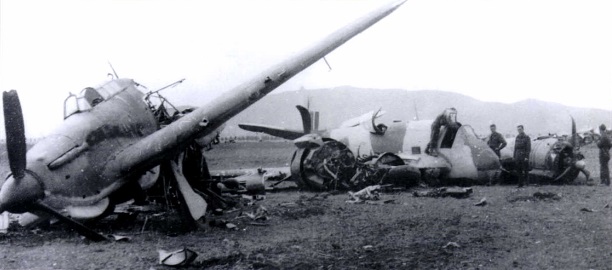 |
Who parked that Hurricane there?
Photographer unknown. |
The night of the 16/17 December saw Flying Officer Greaves (Pilot) and Warrant Officer Robbins (Navigator/Radio) in an even greater spot of bother after shooting down a He.111. Having opened fire from a range estimated at no more than 50 feet, the Beaufighter flew right through the curtain of fire and debris that resulted from the German bomber exploding. The ORB reports...
Emerging the other side F/O Greaves found his cockpit completely blacked out and, according to his instruments, he was doing a steep turn to starboard. Putting the wheel fully over to port the turn to starboard continued at rate 1 in an inexplicable and alarming manner... Pilot then throttled back the port engine and managed to fly the aircraft straight. He then opened one of his clear vision panels and contrived to scrape quite a lot of the newly acquired camouflage off the windscreen. Although the controls were exceedingly bad owing to the fact that the starboard aileron had been burnt off completely, the pilot succeeded in flying the Beaufighter to Bône...[26]
This feat of survival was later to feature in the citation relating to the award of the DFC to Flying Officer Greaves.
Christmas Day 1942 did not pass without celebration, although at Sétif normal work took place until 17:00 hours. Then a dinner of chicken, turkey or steak & kidney pudding, with a ration of one bottle of beer. The Souk-el-Arba site managed a bit better, procuring local wine and temporarily borrowing an agricultural barn from a local Arab for use as a dining hall and venue for a well-oiled sing song.
[27] [28]
The remainder of the month was fairly quiet, but on the 29th Flying Officer Kendall and Pilot Officer Hill claimed a four-engined enemy aircraft "with eight exhaust flames" as damaged. The identity/aircraft type of this target has never been conclusively established. The chase might have been successful had not the Beaufighter’s presence been given away by Allied searchlights located at Bône illuminating it rather than the target it was chasing.
[29]
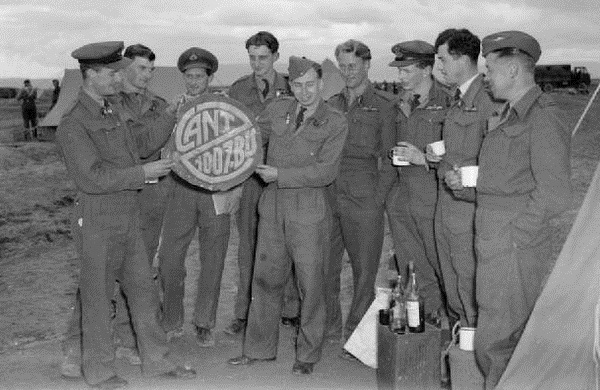 |
Flying Officer D H Greaves (far left) and Warrant Officer F M Robbins (fifth from left)
display a trophy cut from their fifth victim, a Cant Z1007bis. [Photo: IWM. Public Domain] |
Flight Lieutenant J.D.Wright and Flying Officer Sandow opened the 1943 scoresheet in the squadron’s favour by downing a Do.217 on 2 January 1943 and on the 6th there was further cause for celebration when notification of the award of four DFCs (Player,
[30] Lammer, Gloster and Oswald
[31]) arrived simultaneously.
The tally took a turn for the worse on the 7th, when 119195 Flying Officer Ronald Victor Weston and 116704 Flying Officer Charles Reginald Hiles were killed in the crash of V8547; the aircraft flew into a cliff near Bône Harbour whilst attempting to land there following loss of one engine (cause unknown).
Numerous skirmishes between the Squadron’s Beaufighters and both Luftwaffe and Regia Aeronautica bombers and fighter-bombers continued throughout the month. There was one daytime incident at Souk-el-Arba meriting special mention – at 13:00 on the 26th, an Axis air raid on the airfield resulted in the death of 952323 Leading Aircraftman Owen Loy (Armourer’s Assistant) who was killed by shrapnel, the second such victim of bombing raids on the squadron’s airfields in North Africa. Two Beaufighters were destroyed in the same raid and a further two damaged.
[32]
February saw the first creation of a proper rest facility, away from the daily routine of the airfields. A good site was discovered at Cap Tichy, ten miles east of Bougie (since renamed Béjaïa). It included a number of chalets, which were duly requisitioned by the Army Hiring Officer for the area. This proved to be a great success, so much so that the exercise of creating a designated "R&R" facility on a nearby coast was later repeated in southern Italy.
The weather wasn’t exactly suited to holidays, though. On 10 February, snow fell at Sétif. The airfield site being 1,038 metres above sea level, this was not abnormal, Sétif averaging 11 days of snow per year.
The very end of February marked the commencement of a technical problem that took a while to resolve. Unannounced, replacement Beaufighters arrived equipped with the new and somewhat hastily produced Mk.VII AI sets, which were in essence pre-production versions of the Mk.VIII. The new equipment functioned in a very different way to the Mk.IV, using 9.1 centimetre (3 GHz microwave) signals rather than the 1.5 metre (193 MHz VHF) signals of the older equipment. Not only did the Mk.VII sets require somewhat different display interpretation by the Navigators, but also the change affected tactics because they could be operated much closer to the 'deck' than the old sets. Re-training in the field was necessary.
[33]
Problematically, there were IFF incompatibilities that threatened to label friendly aircraft as foe for want of an IFF signal showing otherwise. The risk of mis-identification of targets and consequent friendly fire casualties rose significantly. Until such time as the whole Wing was completely re-equipped with new aircraft using exclusively centimetric radar, it became necessary to ensure that all fighter aircraft in the air at any one time had either VHF or S-Band equipment – never a mixture.
[34] Even within the one squadron that change-over did not complete until August 1943, just prior to the Squadron’s departure to Sicily.
As if the IFF issue wasn’t enough, the S-Band equipped Beaufighters were unable to make use of VHF Radar Beacons.
The beginning of March was eerily quiet, with successive days logging "no enemy activity". On the eighth, the CO Wing Commander Piers Kelly was posted to NACAF headquarters in Algiers to become overall commander of Night Operations. Squadron Leader J.H.Player, DFC, was promoted to Wing Commander and assumed command of the squadron. Flight Lieutenant P.W.Dunning-White, DFC, was promoted to the rank of Squadron Leader and assumed command of 'B' Flight.
[35] Plans were made to move the camp away from Macdonald, on account of anticipated malaria problems in summer weather.
On the sixteenth, notification was received of the award of DFCs to Flying Officer D.H.Greaves and Warrant Officer F.M.Robbins.
[36]
March 1943 also saw the squadron’s first instance of a Field Court Martial, the accused being 1133736 AC1 Marland and 1059310 LAC Whiskie. The charges related to the theft of clothing and boots from stores and subsequent sale to "an Arab". Both were found guilty and sentenced to Field Punishment.
[37]
On the 21st, seven aircrews relocated to Bône in readiness for Intruder Operations over Sardinia. This marked a significant extension of the squadron’s role; no longer just on the defensive but carrying the fight into enemy airspace.
The first such intruder operation took place on the night of 23/24 March 1943, Flying Officer M.J.Gloster, DFC (Pilot) and Flight Sergeant R.B.Wall (Navigator Radio) as crew. Due to a shortage of proper paperwork, the combat report was typed on small slips of paper, which (being the first such mission) is quoted here in full...
Beaufighter aircraft. Intruder Report. Resta 33. Took off 20.00 from Bone landed 23.10 at Setif. Scrambled for Forfar (Controller S/L Brown) vectored from Cap Takouch on 340° at 8,000' for 40/50 miles. Given course of 040° at 280 mph I.A.S. for Elmas. Put on to a Bandit at 5,000'. Given various north and north vectors [sic]. Instructed to make a complete orbit and then vector 040°. Target speed 120 mph. Shortly afterwards told to abandon chase as target was very difficult. Given 070° and 040° and height increased to 12,000'. R/T silence was maintained from Algerian Coast. Coast of Sardinia crossed at 20.55 hours west of Cap Spartivento at 9,000'. On nearing coast peculiar noise heard over R/T, may have been R.D.F. sweeping. This interference was heard at intervals all the way to Cagliari. Many lights seen on ground, black out poor. Several lighthouses seen operating. What appeared to be two flares seen in Sant Antioco direction and later others over Cagliari harbour. Flying at 9/10,000' flarepath of an aerodrome seen, believed to be Decimomannu. Pilot flew north of aerodrome to get reflection of moon on water to pin point position. Two aircraft with navigation lights seen orbitting aerodrome. Height reduced rapidly to 1,500'. Lights seen approaching rapidly. Pilot turned away quickly as a Ju.88 passed just over from starboard to port 50' away. Six to eight aircraft were seen orbitting aerodrome burning very bright navigation lights, one aircraft having cockpit lights. Singals with downward recognition lights seen. Several aircraft passed very close to Beaufighter which took avoiding action. Two yellow single star Verey lights fired from ground, then as Beaufighter went round a green was fired as if giving permission for the Beaufighter to land. Aircraft in front of Beaufighter made frantic signals with navigation lights and turned in. Beaufighter followed, and attacking from starboard and astern fired at lights. Range difficult to estimate, thought to be approximately 100 yards. Two one second bursts with all guns given. Strikes seen on enemy aircraft believed to be port wing. No silhouette seen and pilot found it difficult to estimate deflection. It was thought too little deflection given. After second burst Beaufighter pulled away to starboard diving to ground level. Navigator Radio saw silhouette of twin engined aircraft against sky with smoke coming from port engine. Beaufighter flew north west behind hills. Flarepath still on as Beaufighter went to full speed along a valley below level of hills. After attack pilot saw a red star cartridge which appeared to have been fired by another aircraft. Route taken round Mount Linas and down coast, crossing coast at GULF OF PALMS at 21.40 hours. Pilot set course of 200° at Toro flying at 2,000'. Forfar was heard loud and clear over Decimomannu when at 8,000'. No return fire, no searchlights, or flak. Speed of Beaufighter over Sardinia maintained at 240/250 mph I.A.S. Evasive action taken whole time whilst over Sardinia by diving turns of from 30/60° with changes of 1,000' in height. Very bright lights circled the aerodrome, probably round the perimeter track. Resembled Neon lights. Claim: One twin engined enemy aircraft damaged.[38]
Meantime, other members of the squadron were engaged in many convoy protection patrols, all of which were uneventful. But the non-appearance of the enemy meant success and the navy appreciated it, conveying a message of thanks on the 29th that made particular mention of callsigns Resta 31 (111570 Flying Officer Leslie James Leppard) and Resta 27 (Flying Officer Geoffrey Humes).
[39]
April Fool’s Day brought the first loss during an intruder mission. That evening, 66570 Flying Officer Geoffrey Humes (Pilot) and 1062107 Flight Sergeant John Lindsay Sayer (Navigator Radio) took off from Bône at 21:00 hours. The last radar plot was at 21:58, six miles off the coast of Sardinia. The aircraft did not return and the crew were initially posted as missing in action, only later being listed as killed. They are both commemorated on the Malta Memorial.
On the sixth, the move out of Macdonald to the new campsite at Ain Arnat was completed.
The twelfth saw a successful Air Sea Rescue operation. A Radio Observer from another squadron had baled out over the sea. He and his dinghy were eventually spotted by Flight Lieutenants Graham and Murfin and a launch was guided to the scene in an operation that lasted some three hours.
[40]
Every so often, good fortune (or good intelligence) resulted in a fighter squadron engaging in a proverbial Turkey Shoot. No.255 Squadron had enjoyed one such bonanza on 9 May 1941, just before leaving RAF Kirton Lindsey. Another took place on 13 April 1943, when the squadron was ordered by NACAF to send two Beaufighters to patrol a 40-mile north-south line sixty miles west of Southern Sardinia, with the intent of intercepting Axis torpedo bombers expected to attack a large convoy of Allied ships proceeding eastwards from Gibraltar.
The new CO (Johnnie Player) decided to send three sections of three Beaufighters on this daylight mission, a course of action potentially open to criticism on the grounds that it might have compromised the intelligence source. Nine Beaufighters in the air together, by day, was to say the least unusual. They would not have been there in such numbers by coincidence. But, as things turned out, the show of force was needed. A mixed bag of Ju.88s, He.111s and at least one Do.217 duly showed up.
The squadron’s total claim was modest – one Do.217 destroyed, one Ju.88 destroyed and another probably destroyed, two further Ju.88s and two He.111s damaged. But the primary objective of protecting the convoy was achieved. The remaining enemy aircraft dropped their torpedoes, scattered and fled without ever coming within range of their target. One Beaufighter was hit by enemy fire; 123299 Flying Officer Frank Hancock Street was hit in the leg and the aircraft lost one engine. The Beau was seen to turn for home, but Street and his navigator 1103218 Flight Sergeant Gilbert Llewellyn Thomas never made it home. Extensive searches were organised but no wreckage was ever found.
[41] At the same time as that search, a crew on detachment to No.153 Squadron – 116059 Flying Officer John David Annesley Tharp and 132988 Pilot Officer David Arthur King – went missing from a patrol commencing at Maison Blanche. Searches continued until the weather broke on the 15th.
[42] The names of these four men also appear on the Malta Memorial.
A particularly cheeky intruder mission was mounted from "Paddington" (Souk-el-Khemis) on the night of 5/6 May 1943, the aircrew being Flying Officer P.S. Kendall, DFC, and Pilot Officer D.M. Nedhal. German troop transport aircraft (Ju.52s) were being flown into El Aouina airfield (now the site of Tunis-Carthage International Airport). Kendall and Nedhal joined the queue of between 15 and 20 aircraft waiting to land, shooting down one and claiming another as probably destroyed. The attack almost resulted in a mid-air collision; the airspeed of a Ju.52 on final approach, undercarriage and flaps down, was about 75 mph – below the stalling speed of a Beaufighter. The combat report states that the Beaufighter came within 25 yards of catching up one enemy aircraft before the damage done to it resulted in it diving into the ground.
[43] (Note: An error in the Form 541 in respect of this incident describes the target as a Ju.88. That cannot be, because – like a Beaufighter – a Ju.88 would have stalled at 75 mph IAS.)
Copyright © 2014–2026. All rights reserved except where otherwise stated.
